Materiathek Bücher
Aus exmediawiki
zurück zu Matheriathek
Übersicht über Bücher in der Bibliothek.
Stoffe in Bewegung
Beiträge zur einer Wissensgeschichte der materiellen Welt
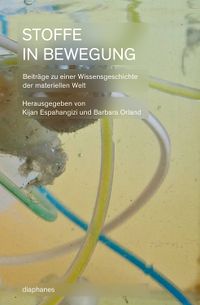
AutorIn: Kijan Espahangizi
Jahr: 2014
Verlag: Diaphenes
Signatur: GES B.3.3 - 32
Alles ist im Fluss – diese antike Weisheit feiert im durchglobalisierten Weltgeschehen fröhliche Urstände. Mobilität und Wandel sind die kategorischen Imperative der Zeit. Auch Stoffe bewegen sich rastlos über den Erdball, ebenso wie durch unsere Körper, werden fortlaufend umgestaltet und konstituieren so die materielle Welt, wie wir sie erleben. Ausgehend von diesem Befund wird eine Wissensgeschichte dieser materiellen Welt anvisiert, die nicht Strukturen, sondern stoffliche Überführungen und Umwandlungen – räumlich, zeitlich und substanziell – ins Zentrum rückt. Ohne der Versuchung zu erliegen, die Physikochemie mit ihrem elementaren Baukastenprinzip der Materie oder theoretische Figurationen aktueller Diskurse – Stoffkreislauf, Zirkulation, Stoffwechsel, Materialfluss – als historische Apriori zu setzen, entwickeln die Beiträge eine von Prozessen und Bewegungen ausgehende Natur- und Kulturgeschichte der materiellen Welt.
https://www.diaphanes.de/buch/detail/2416
Art, Biology & Conversation
Biodeterioration of Works of Art
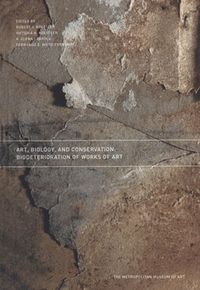
AutorIn: Koestler, Robert J., Victoria H. Koestler, A. Elena Charola, and Fernando E. Nieto-Fernandez
Jahr: 2004
Verlag: Yale Univ. Press
Signatur: KUN C.7 - 65
The interface of art, science, and conservation is an exciting place. That's what we at the Metropolitan Museum of Art discovered in June 2002 when we hosted a three-day symposium that brought these areas together. The first such conference ever held at the Met, the Art, Biology, and Conservation 2002 meeting provided an opportunity for close to 40 scientists and conservators to present their latest research on the interactions of microbes and art, and to offer approaches to counter the effects of biodeterioration.
As I noted at the time, no work of art is immune to microbial attack. Microbes, being cosmopolitan, are a threat to art collections worldwide, as they are always present in the environment, lying dormant, and waiting for the right conditions to occur so they can flourish. Such conditions include subtle environment changes, such as a temporary increase in moisture level, as well as major events, such as a water leak; both can foster an infestation within just hours. Whether this leads to serious damage depends on many factors, including the material composition of the art, the amount of water present, the species of microbe on the art, and how long conditions are favorable for growth. Once such mishaps occur, the work of scientists and conservators becomes vital, as they strive to protect our often fragile cultural heritage.
The papers in this volume detail the work of the select group of biologists and conservators that came together at ABC2002 to show how they are addressing these concerns. A wonderfully diverse group, they had in common a desire to preserve the historic and the beautiful, the skills to do so, and an excitement about the whole process. I think that excitement comes through in this volume as well.
Art in the Making
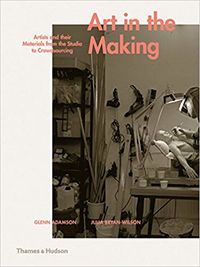
Artists and their Materials from the Studio to Crowdsourcing
AutorIn: Glenn Adamson, Julia Bryan-Wilson
Jahr: 2014
Verlag: Thames & Hudson
Signatur: KUN C.0 - 309
Today, artists are able to create using multiple methods of production from painting to digital technologies to crowdsourcing some of which would have been unheard of just a few decades ago. Yet, even as our means of making art become more extraordinary and diverse, they are almost never addressed in their specificity. While critics and viewers tend to focus on the finished products we see in museums and galleries, authors Glenn Adamson and Julia Bryan-Wilson argue that the materials and processes behind the scenes used to make artworks are also vital to current considerations of authorship and to understanding the economic and social contexts from which art emerges.This wide-ranging exploration of different methods and media in art since the 1950s includes nine chapters that focus on individual processes of making: Painting, Woodworking, Building, Performing, Tooling Up, Cashing In, Fabricating, Digitizing, and Crowdsourcing. Detailed examples are interwoven with the discussion, including visuals that reveal the intricacies of techniques and materials. Artists featured include Ai Weiwei, Alice Aycock, Isa Genzken, Los Carpinteros, Paul Pfeiffer, Doris Salcedo, Santiago Sierra, and Rachel Whiteread.
https://www.amazon.de/Art-Making-Artists-Materials-Crowdsourcing/dp/0500239339
From painting to digital technologies to crowdsourcing, over the last few decades the means of making artworks have become more extraordinary and diverse. Yet we rarely consider the implications of how art is made. In this wide-ranging exploration of methods and media in art since the 1950s Glenn Adamson and Julia Bryan-Wilson take the reader behind the scenes of the studio, the factory, and other sites where art is created. They show how the materials and processes used by artists are vital to considerations of authorship, and to understanding the economic and social contexts from which art emerges. Art in the Making focuses on the intersection of thinking and making through chapters focusing on a particular process: painting, woodworking, building, performing, tooling up, cashing in, fabricating, digitizing and crowdsourcing. Discussions of broader themes are woven together with detailed examples and visuals, revealing the logic involved in the choice of techniques and materials. Artists featured include Alice Aycock, Judy Chicago, Isa Genzken, Los Carpinteros, Paul Pfeiffer, Doris Salcedo, Santiago Sierra and Rachel Whiteread.
https://thamesandhudson.com/how-is-contemporary-art-made-9780500239339
Beton, Klinker, Granit
Material, Macht, Politik - eine Materialikonographie
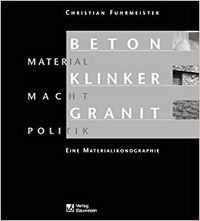
AutorIn: Fuhrmeister, Christian
Jahr: 2001
Verlag: Verl. Bauwesen
Signatur: KUN B.7 - 34
Die Studie untersucht die Bedeutung des Baumaterials anhand architektonischer Denkmäler der Weimarer Republik und des Nationalsozialismus. Sie bestätigt die These, dass die politische Aussage abstrakter, nicht-figurativer Formen vor allem durch das Material erzeugt wird. Anhand zahlreicher neuer Quellen wird die Ideologisierung natürlicher und künstlerischer Steine erstmals gründlich beleuchtet. Im Zentrum stehen Walter Gropius´ Märzgefallenen-Denkmal in Weimar (1921), Mies van der Rohes Revolutionsdenkmal in Berlin (1926) und Clemens Holzmeisters Schlageter-Denkmal in Düsseldorf (1931).
Mit zahlreichen Abbildungen. Bauten und Bauherren steht nicht nur die Form, sondern auch das spezifische Material zur Verfügung, um eine politische Aussage zu transportieren. Welch entscheidende Rolle das Material bei der Planung und Entstehung der Denkmäler der Weimarer Republik und des Nationalsozialismus spielte, macht Christian Fuhrmeister deutlich: Anhand zahlreicher, bisher vernachlässigter Quellen zu den wichtigsten Denkmälern der 20er und 30er Jahre wird der historische Kontext der Ideologisierung natürlicher und künstlicher Steine erhellt. Erstmals werden das Märzgefallenen-Denkmal von Gropius, Mies van der Rohes Revolutionsdenkmal und Holzmeisters Schlageter-Denkmal mit der nationalsozialistischen Natursteinbesessenheit eines Wilhelm Kreis oder Albert Speer in Beziehung gesetzt.
https://www.perlentaucher.de/buch/christian-fuhrmeister/beton-klinker-granit.html
And Materials and Money and Crisis
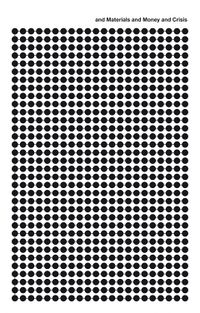
AutorIn: Birkett, Richard
Jahr: 2013
Verlag: König
Signatur: KUN B.6.14 - 708
Die Gruppenausstellung and Materials and Money and Crisis setzte sich in experimenteller Form mit Kapital als Material auseinander, wie es im Kunstwerk existiert. Die vom New Yorker Kurator Richard Birkett im Dialog mit dem Künstler Sam Lewitt kuratierte Ausstellung zeigte Arbeiten von elf KünstlerInnen, darunter eigens für die Ausstellung in Auftrag gegebene sowie ältere Werke, die für das mumok neu bearbeitet wurden. Der Begriff Material hatte in diesem Ausstellungsvorhaben eine doppelte Bedeutung: Zum einen dienten die Flüsse von Material und Geld – wie auch die Krisen, die zu einer Verlangsamung dieser Flüsse führen – als Motiv . Zum anderen beinhaltete das Thema die weiterführende Frage, in welcher Beziehung das physische Material des Werks zur Ablösung des Kapitals von der Produktion steht, wie sie sich in der Finanzwelt beobachten lässt.
and Materials and Money and Crisis rückte die Arbeit von KünstlerInnen ins Blickfeld, die den Zusammenhang dieser drei Begriffe auf unerwartete Art und Weise darstellten.
Teilnehmende KünstlerInnen waren: Terry Atkinson, Maria Eichhorn, Melanie Gilligan, Gareth James, Pratchaya Phinthong, Sam Lewitt, Henrik Olesen, R. H. Quaytman, Lucy Raven, Cheyney Thompson und Emily Wardill.
https://www.mumok.at/de/events/and-materials-and-money-and-crisis
Kunst und Textil
Stoff als Material und Idee in der Moderne von Klimt bis heute
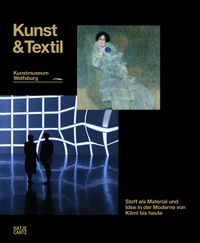
AutorIn: Markus Brüderlin, Marie-Amélie zu Salm-Salm, Julia Wallner, Uta Ruhkamp, Hartmut Böhme
Jahr: 2013
Verlag: Hatje Cantz
Signatur: KUN B.6.16 - 936
Die Digitalisierung der Welt scheint einen Abgleich mit der Hand zu benötigen. Allerorten wird gehäkelt, gestickt, gestrickt und gewebt. Die Grenzlinie zwischen Kunst und Kunsthandwerk scheint zu verwischen. Bereits 1878 beschrieb Gottfried Semper das Textile als Urform der Künste. Wiener Werkstätte und Bauhaus durchbrachen die Schranken, ein entscheidender Impuls für die Meister der Moderne. Faden, Gewebe, Netz und Muster sind gleichzeitig Grundlage, Ergebnis und Ideengeber, greifen auf Malerei, Skulptur, Installations- und Medienkunst über.
Der opulent gestaltete Band offeriert einen künstlerischen und zugleich interkulturellen Dialog und stellt Werke von Gustav Klimt, Edgar Degas, Jackson Pollock, Eva Hesse, Chiharu Shiota oder Sergej Jensen historischen Textilien vergangener Jahrhunderte gegenüber. In interdisziplinären Textbeiträgen werden Material und Idee des Textilen umfassend diskutiert.
https://www.hatjecantz.de/kunst-und-textil-5658-0.html
Digital Materiality in Architecture
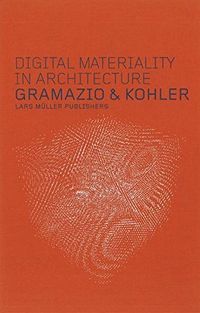
AutorIn: Gramazio, Fabio; Kohler, Matthias
Jahr: 2008
Verlag: Müller
Signatur: KUN I.6 - 55
Robots build! At their program in architecture and digital production at the Eidgenössische Technische Hochschule (ETH) Zürich (Swiss Federal Institute of Technology in Zurich), the architects Gramazio and Kohler have installed a research facility that is unique in the world. It is based on a computer-controlled industrial robot that produces construction elements directly from design data. The robot works flexibly with a tremendous range of tools and materials. In this way Gramaio and Kohler probe the exciting potential of digital design, construction, and manufacturing techniques for architecture. In their projects they incorporate insights and discoveries from the field of computer-aided production into the architectonic design process, using computers to develop innovative construction techniques and architecture. First structures using robots have already been built, for exampe the much noted Gantenbein vineyard in Fläsch (CH) or the installation at the Swiss Pavilion at the 11th International Architecture Exhibition in Venice.
https://www.ivorypress.com/es/libreria/shop/digital-materiality-in-architecture/
It´s been a while since the last lecture I posted here so its time to get back to it , here is a very good one I stumble upon today with the subject of Digital Materiality by Gramzio & Kohler who talk about their research with digital media & fabrication projects.They talk about their idea of digital materialisation that talks about how combining simple materials with digital information and technologies a whole new world of expressions and aesthetics emerge .
I you have two spare hours I would really recommend it specially for those wanting to understand better the connection between programming and architecture and how digital media is not only a set of tools for working but how is actually changing the whole concept and aesthetics of architecture itself.
http://designplaygrounds.com/tv/digital-materialisation-gramazio-kohler/
Extreme Textiles
Designing for High Performance
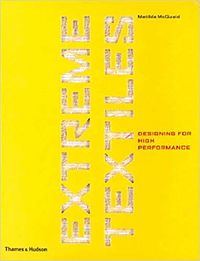
AutorIn: MacQuaid, Matilda; Beesley, Philip
Jahr: 2005
Verlag: Thames & Hudson
Signatur: KUN H.5.4 - 38
Stronger, faster, lighter, safer, smarterthese are the textiles of tomorrow. From the carbon-fiber composite bicycle frame to the cardiac constraint sock and the Mars Pathfinder landing airbags, material innovations surround us. Our landscape, our buildings, our vehicles, our clothes, and our bodies all benefit from these highly engineered performance textiles. Featuring examples of fully realized products from all classes of technical textilesarchitectural, product design, apparel, medicine, transportation, aerospace, industry, and the environmentExtreme Textiles highlights successful collaborations between design, industry, and science. Large, full-color illustrations and essays by some of today's most influential designers and scientists trace the extraordinary developments made in textiles over the last twenty years and suggest what is to come.
Tradition, technology, beauty, and strength are joined together in the materials and products presented in this volume. Whether exploring space, running a marathon, or fashioning the latest trend, we will be inspired by these extreme textiles every day.
Extreme Textiles accompanies the exhibition of the same name at the Cooper-Hewitt, National Design Museum beginning in April 2005.
https://www.goodreads.com/book/show/57592.Extreme_Textiles
Handbuch Material Technologie
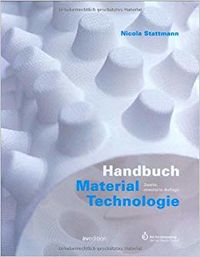
AutorIn: Strattmann, Nicola
Jahr: 2003
Verlag: AV Ed.
Signatur: KUN H.5.0 - 7(2)
Die Materialforschung und -technologie entwickelt sich in rasantem Tempo. In den letzten beiden Jahren gab es viele Neuentwicklungen, die Nicola Stattmann in die Neuauflage ihres Handbuchs eingearbeitet hat.
Das Buch präsentiert verschiedenste Materialien, mit denen Produktdesigner täglich arbeiten. Dazu gehören Naturmaterialien, die ersten Kunststoffe, intelligente Oberflächen mit High-Tech-Qualitäten u.v.a. Außerdem werden Technologien vorgestellt, mit diesen Materialien umzugehen: Blasformen von Metallen, Schweißen von Keramik etc.
Abschließend zeigt das Buch die Entwicklung der Werkstoff- und Technologieforschung auf - und veranschaulicht faszinierende Materialmöglichkeiten bei der zukünftigen Herstellung von Produkten.
https://www.beck-shop.de/stattmann-handbuch-material-technologie/product/361316
TITEL
UNTERTITEL
AutorIn: NAME
Jahr: JAHR
Verlag: VERLAG
Signatur: SIGNATUR
BIBSEITE
FLIESSTEXT
QUELLE
TITEL
UNTERTITEL
AutorIn: NAME
Jahr: JAHR
Verlag: VERLAG
Signatur: SIGNATUR
BIBSEITE
FLIESSTEXT
QUELLE